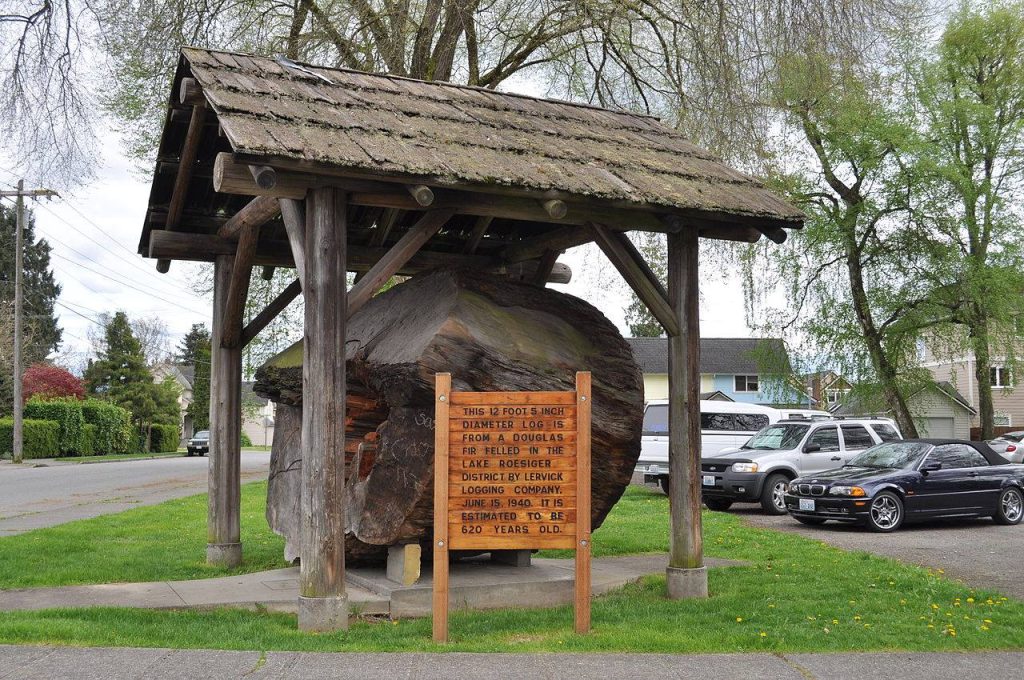Beneath the emerald canopy of Snohomish, a story unfolds among the city’s winding streets, rooted in history and nature. The city’s past isn’t just found in dusty documents and records, ancient cemeteries, old buildings, or the antique market; it’s famously known as the Antique Capital of the Northwest. It’s also written in the rings of its trees.
With a Snohomish tree tour, these arboreal archives offer a glimpse into the region’s past through the eyes of its oldest residents, their stories seemingly whispering in the wind with the rustling of the leaves and their roots reaching down deep to anchor generations together before intertwining like the enduring bonds of the community we all call home.

Sugar Maples Have Sweetened Snohomish
The sugar maple that decorates the front lawn of 311 Avenue C in Snohomish was planted by the city’s first mailman, Robert Hazeltine, in the early 1900s. Hazeltine had brought the tree here from his hometown in Whitehall, Michigan. The tree served as a reminder to the transplanted family’s roots as those on the young sapling intertwined with the new soil, promising a bright future all while intertwining with their past.
Not too far away, another sugar maple can be found on the northwest corner of Lincoln and Willow Avenues. Similar to the one on Avenue C, this one was also planted at the beginning of the 20th century in 1909 by Howard Clemans and his wife, Nellie. Howard, along with three of his brothers and one of his sisters, had recently made their way to Snohomish from Iowa in the late 1800s, seeking better opportunities in the Pacific Northwest. His older brother Carl Lane Clemans, with whom the group was following, would go on to purchase the local newspaper “Tri-Weekly Tribune.” The tree, which still stands today, was planted in honor of Howard and Nellie’s firstborn son, Robert.

A Canopy of Knowledge Surrounds Snohomish Historic Buildings
Constructed in 1910 after a generous donation of $10,000 from philanthropist Andrew Carnegie, the Snohomish Carnegie Library was set on a large, landscaped site that contained many beautiful mature trees, which have been identified by the city survey for preservation, ensuring that they still stand today. A European beech can be found near the entrance of the historic building. An American elm can be found close by on Pearl Street, a lone remnant of a once larger grouping of the mighty pillars. On the alley next to 703 1st Street sits a copper beech, also known as a purple beech for the species’ purple leaves. It’s incredible to think that these three magnificent specimens have seen just as much of Snohomish’s evolution as the library itself.
Similarly, the historic Snohomish City Hall, formerly the Snohomish Post Office, has its own set of pin oaks, with these arbor guardians solemnly overlooking the unfolding of time within the city. The two large giants are home to a number of crows who feed on their “pin” sized acorns. After years of growth, the one on the left had to be dramatically trimmed in 2017 in an attempt to save it from splitting down the middle.

Several Champion Trees of Washington State Have Roots in Snohomish
Written by Robert Van Pelt and first published in 1996, “Champion Trees of Washington State” documents the largest known trees within the Evergreen state, otherwise known as champion trees. A number of these impressive specimens featured in the book can be found right here in Snohomish.
The outstanding Chinese Chestnut on the property of the historic 1902 Hendrie House was one such tree included on the list. The tree is as old as the house itself; one of the town’s first druggists, Mr. Hendrie, brought it here as a seedling from his native New England.
A nearby Japanese walnut on the same street also holds a champion tree title in the book, with Van Pelt crediting this particular Japanese walnut with having the “largest crown.”

Walking Where Roots Run Deep in Snohomish
Of course, these aren’t the only roots embedded in Snohomish history. Various other tree species can be found scattered all across town, from English walnuts to Camperdown elm, giant sequoia to kousa dogwood and everything in between. There are even rarities, such as a monkey puzzle tree on 3rd Street and a ginkgo next to the alley on Avenue D.
All these beautiful heritage trees and more can be explored in a multitude of ways. Whether it be through a self-guided tour, a walking tour with a knowledgeable guide, or the new shuttle tour, Green Snohomish is more than happy to take residents and visitors alike on a magical journey on the trees that not only shade Snohomish but have rich roots in the city’s past, present, and future.










































